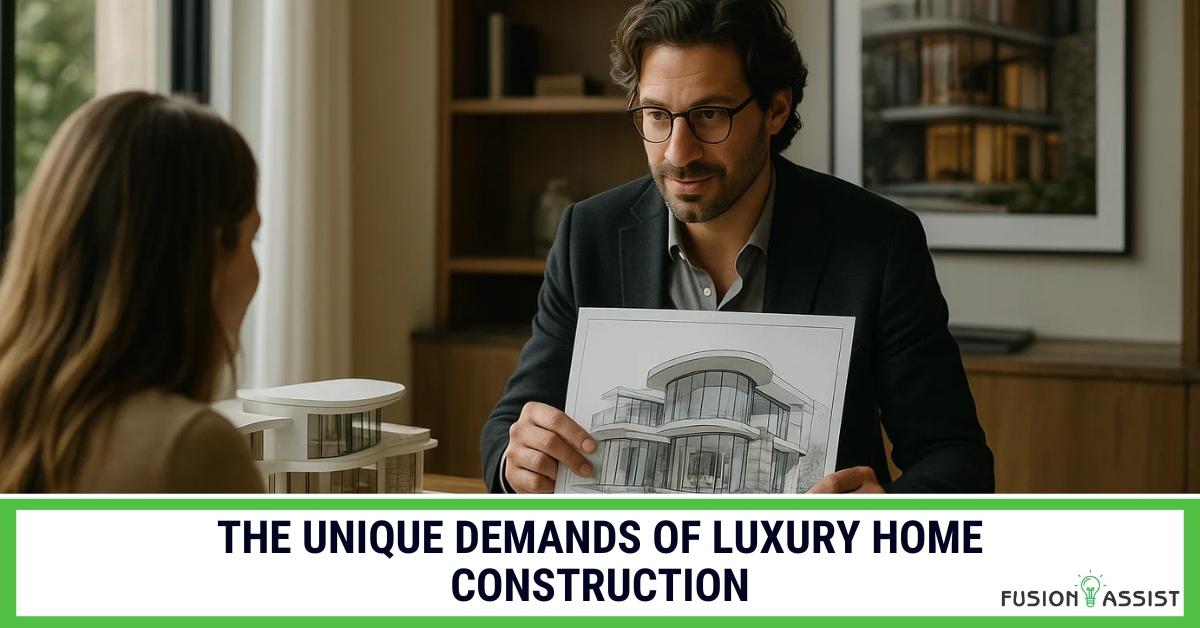Introduction
Luxury home construction is often seen as the pinnacle of the construction industry. It combines the highest standards of craftsmanship, cutting-edge technology, and unparalleled attention to detail. However, the journey from concept to completion is fraught with challenges that can test even the most experienced builders. In this article, we will delve into the common obstacles faced during luxury home construction and provide actionable insights on how to overcome them. Whether you are a seasoned contractor or a homeowner embarking on a luxury project, understanding these challenges and their solutions can make all the difference.
The Unique Demands of Luxury Home Construction

Luxury home construction is not just about building a house; it’s about creating a masterpiece. Homeowners who invest in luxury properties expect nothing less than perfection. This high expectation brings a unique set of challenges that can be broadly categorized into design, budget, timeline, and quality control.
Unlike conventional home construction, luxury projects are driven by personalization, exclusivity, and top-tier quality. Each home is a reflection of the owner’s lifestyle, taste, and aspirations, which means standard building templates rarely apply. Every element—from the architectural style and spatial layout to the materials and finishes—is tailored to meet a precise vision. This level of customization increases the complexity of both planning and execution.
Additionally, luxury homes often integrate cutting-edge technologies such as smart home automation, sustainable energy systems, and advanced security features. These sophisticated installations require specialized knowledge, precise coordination, and a proactive approach to problem-solving.
High-end clients also expect seamless communication, detailed reporting, and full transparency throughout the construction process. Builders must balance artistic creativity with rigorous project management to meet these elevated expectations. In many cases, luxury construction demands a level of foresight and adaptability that surpasses standard practices, especially when navigating zoning laws, environmental constraints, or unique site conditions.
Ultimately, luxury home construction is a multidisciplinary endeavor that requires exceptional attention to detail, a commitment to excellence, and a highly skilled team. Understanding these unique demands is the first step in delivering a residence that embodies true luxury and lasting value.
Challenges in Luxury Home Construction

1. Design Challenges
Innovative and Customized Design Requirements
Luxury homes are often characterized by their unique and innovative designs. Homeowners may have specific visions that require custom solutions, from bespoke architectural elements to intricate interior details. This can lead to several challenges:
- Complex Architectural Plans: Custom designs often involve complex architectural plans that require specialized skills and expertise. Builders must work closely with architects to ensure that the design is not only aesthetically pleasing but also structurally sound.
- Integration of High-End Materials: Luxury homes often incorporate marble, exotic woods, and custom glass. These materials can be difficult to source and require specialized handling and installation techniques.
Actionable Insights
- Collaborative Design Process: Foster a collaborative environment between architects, designers, and builders. Regular meetings and open communication channels can help identify potential issues early and ensure that all parties are aligned.
- Material Sourcing and Management: Develop strong relationships with reputable suppliers to ensure timely delivery and quality of materials. Consider using a dedicated material manager to oversee the sourcing and storage of high-end materials.
2. Budget Challenges
High Costs and Budget Overruns
Luxury home construction is inherently expensive. Using premium materials, specialized labor, and custom designs can quickly escalate costs. Budget overruns are a common issue, often caused by unforeseen expenses and changes in scope.
Actionable Insights
- Detailed Cost Estimates: Invest in detailed and accurate cost estimates at the outset of the project. Use historical data and industry benchmarks to account for potential cost increases.
- Contingency Planning: Allocate a contingency budget to cover unexpected expenses. This should be a percentage of the total project cost and should be revisited regularly to ensure it remains adequate.
3. Timeline Challenges
Extended Project Durations
Luxury home construction is a time-consuming process. Complex designs, custom elements, and high-quality standards can significantly extend project timelines. Delays can lead to increased costs and dissatisfied clients.
Actionable Insights
- Project Management Software: Utilize project management software to track progress, manage resources, and identify potential delays. Regular project reviews and status updates can help keep everyone informed and on track.
- Efficient Workflow: Optimize the construction workflow by sequencing tasks effectively. Ensure that all trades know their responsibilities and deadlines, and encourage collaboration to avoid bottlenecks.
4. Quality Control Challenges
Ensuring High-Quality Workmanship
Luxury homes demand impeccable workmanship. Every detail, from the foundation to the finishing touches, must meet the highest standards. Ensuring consistent quality can be challenging, especially when dealing with multiple subcontractors and suppliers.
Actionable Insights
- Quality Assurance Protocols: Implement strict quality assurance protocols at every stage of the construction process. Regular inspections and quality checks can help identify and rectify issues before they escalate.
- Training and Development: Invest in training and development for your workforce. Skilled and knowledgeable workers are more likely to deliver high-quality work.
Real-World Case Studies
Case Study 1: The Grand Oceanfront Estate
Project Overview
The Grand Oceanfront Estate was a luxury home project located on a prime beachfront location. The homeowner envisioned a modern, eco-friendly home with panoramic ocean views and state-of-the-art amenities.
Challenges Faced
- Complex Architectural Design: The design included a cantilevered structure with extensive glass facades, posing significant structural and waterproofing challenges.
- Sourcing Sustainable Materials: The homeowner insisted on using sustainable materials, which were difficult to source and expensive.
- Tight Timeline: The project had to be completed within 18 months to coincide with the homeowner’s relocation.
Solutions Implemented
- Collaborative Design Team: A multidisciplinary team of architects, engineers, and builders worked closely to address the design challenges. Regular meetings and simulations helped visualize and refine the design.
- Sustainable Material Sourcing: The team partnered with a supplier specializing in sustainable materials. They also explored alternative materials that met the homeowner’s sustainability goals without compromising quality.
- Agile Project Management: The project team used agile management techniques to stay on schedule. Regular progress reviews and adaptive planning ensured that any delays were quickly addressed.
Outcome
The Grand Oceanfront Estate was completed on time and within budget. The homeowner was delighted with the result, and the project received accolades for its innovative design and eco-friendly approach.
Case Study 2: The Hilltop Manor
Project Overview
The Hilltop Manor was a luxury home project on a challenging hilltop site. The homeowner wanted a traditional European-style mansion with extensive landscaping and outdoor living spaces.
Challenges Faced
- Site Constraints: The hilltop location posed significant access, grading, and soil stability challenges.
- Custom Millwork and Finishes: The design required extensive custom millwork and high-end finishes, which were time-consuming and expensive.
- Budget Constraints: The homeowner had a strict budget, which was quickly exceeded due to the project’s complexity.
Solutions Implemented
- Geotechnical Engineering: A geotechnical engineer was brought in to assess the site and develop a comprehensive grading and stabilization plan. This ensured the safety and stability of the construction site.
- Pre-Fabrication and Modular Construction: The team used pre-fabrication and modular construction techniques for the custom millwork and finishes to address the time and cost constraints. This reduced on-site labor and minimized delays.
- Value Engineering: The project team conducted a thorough value engineering exercise to identify cost-saving opportunities without compromising on quality. This included re-evaluating material choices and simplifying certain design elements.
Outcome
The Hilltop Manor was completed within the revised budget and timeline. The homeowner was satisfied with the result, and the project showcased the potential of value engineering and modular construction in luxury home building.
Frequently Asked Questions (FAQs)
How can I ensure my luxury home project stays within budget?
Detailed Cost Estimates and Contingency Planning
Invest in detailed and accurate cost estimates at the outset of the project. Use historical data and industry benchmarks to account for potential cost increases. Allocate a contingency budget to cover unexpected expenses and revisit it regularly to ensure it remains adequate.
What are the key factors to consider when selecting materials for a luxury home?
Quality, Durability, and Aesthetics
When selecting materials for a luxury home, prioritize quality, durability, and aesthetics. High-end materials such as marble, exotic woods, and custom glass are often preferred. Ensure the materials meet the design vision and are sourced from reputable suppliers to guarantee quality and timely delivery.
How can I manage the timeline of a luxury home construction project effectively?
Project Management Software and Efficient Workflow
Utilize project management software to track progress, manage resources, and identify potential delays. Regular project reviews and status updates can help keep everyone informed and on track. Optimize the construction workflow by sequencing tasks effectively and ensuring that all trades know their responsibilities and deadlines.
What are the best practices for quality control in luxury home construction?
Quality Assurance Protocols and Training
Implement strict quality assurance protocols at every stage of the construction process. Regular inspections and quality checks can help identify and rectify issues before they escalate. Invest in training and development for your workforce to ensure they have the skills and knowledge to deliver high-quality work.
How can I ensure effective collaboration between architects, designers, and builders?
Collaborative Design Process and Communication
Foster a collaborative environment between architects, designers, and builders. Regular meetings and open communication channels can help identify potential issues early and ensure that all parties are aligned. Encourage a culture of collaboration and mutual respect to facilitate smooth project execution.
Conclusion
Luxury home construction is a complex and rewarding endeavor. While it presents numerous challenges, these can be effectively managed with careful planning, collaboration, and innovative solutions. By addressing design, budget, timeline, and quality control challenges head-on, builders can deliver projects that exceed client expectations and stand the test of time. Whether you are a homeowner embarking on a luxury project or a builder looking to enhance your expertise, understanding these challenges and their solutions is essential for success.
Ready to build the luxury home of your dreams? Partner with Fusion Assist’s top experts to turn your vision into a timeless masterpiece.



